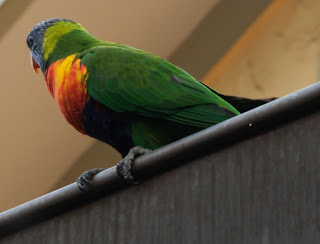“When the red, red robin
comes bob, bob, bobbin' along, along
There'll be no more sobbin'
when he starts throbbin'
his old sweet song
Wake up, wake up you sleepy head
Get up, get up
get out of bed” (Harry Woods)
“Sing for your supper,
And you'll get breakfast.
Songbirds always eat
If their song is sweet to hear” (Lorenz Hart)
One need not be in Australia long to realize that some of the birds did not pay attention in sweet singing class. Sweet?????? You have not lived until you’ve been awakened to the sounds of a flock of cockatoos. Sulphur-crested cockatoos. Birds whose individual “song” is reminiscent of the sound of a ’57 Ford with worn brake pads coming down a steep hill, or, for those of a certain age (hint: you can draw on your Social Security) the sound of Phyllis Diller. Laughing. In your ear. First thing in the morning. On the pillow next to you. (Poor Fang). Cockatoos do NOT sing. The squawk. Loudly. As a group they sound like an angry mob that just discovered Starbucks stopped supplying free WiFi, without the whiny quality one would expect in such a situation.
Though they are apparently monogamous to a point they don’t seem to like each other much. Last night I went for a walk with one of the other tertians. We were in a part of Pymble with very nice houses. The cockatoos were apparently returning to their nests or wherever they spend the night. Poor homeowners. They were chasing each other with nasty intent. Kind of like the Cabbage Patch riots of a few Christmases ago (though a bit more civilized). The noise level was amazing.
The other morning I captured the photos above at 7:10 in the front yard. Why not? Sleep was certainly impossible. Might as well do something productive. Actually, I generally wake at 4:30 and the birds just afterwards at the very first faint rays of light begin to appear. The bird below was feeding in a tree at the Pymble train station the night of the marathon walk with Michael (see earlier blog entry).
He is putting a dainty morsel in his mouth.
Of course Australia has more than cockatoos. Just about the time they seem to have settled down in the morning the kookaburras begin. Wikipedia puts it well: “Kookaburras are best known for their unmistakable call, which sounds uncannily like loud, echoing human laughter — good-natured, but rather hysterical, in the case of the renowned Laughing Kookaburra, and maniacal cackling in the Blue-winged Kookaburra . . .”
RATHER hysterical? How about totally, awesomely, amazingly hysterical? Maniacal is a good word. It understates the situation, but it is a start. The photo of the kookaburra is courtesy of Steve.
And then there are the magpies. The young ones have a “feed me” call that sounds like a primitive Betsy-Wetsy-turn-me-over-and-I-cry doll from the ‘50s. But this doll is bleating into the kind of sound system generally associated with KISS concerts. It takes a few hours here to realize that it is not the sound of an abandoned 3 week-old child somewhere in the hedges. Completely unnerving. The first photo below is young magpie, the one that cries. The other is the adult.
There are some spectacular birds here. Last night I got a bunch of pictures of rainbow lorikeets. Spectacular plumage. There was one sitting on a chair at breakfast this morning but the camera was up in my room. Sigh. These are the lorikeets below.
The gullah birds are yet another form of parrot while not unique to Australia, are, like the lorikeets above, found in a limited range of Australasia. The gullah is below.
This last is one of the pelicans seen floating around Gerroa while we were there. Steve took this one too.
In answer to the question, no, I haven’t seen any kangaroos yet. Perhaps during the long retreat at Sevenhill (population slightly over 400) which is rather isolated. They get up early in the morning but so do I. Some of the guys went to a zoo that contains examples of many of the signature animals of this place (kangaroos, koalas and so on) but other commitments interfered with me being able to go.
Time for the long retreat is rapidly approaching.
+Fr. Jack










Yes, Jack, these are also known as rose-breasted cockatoos. They make awesomely sweet pets. (unlike a lot of other type Toos - like Fred)
ReplyDelete